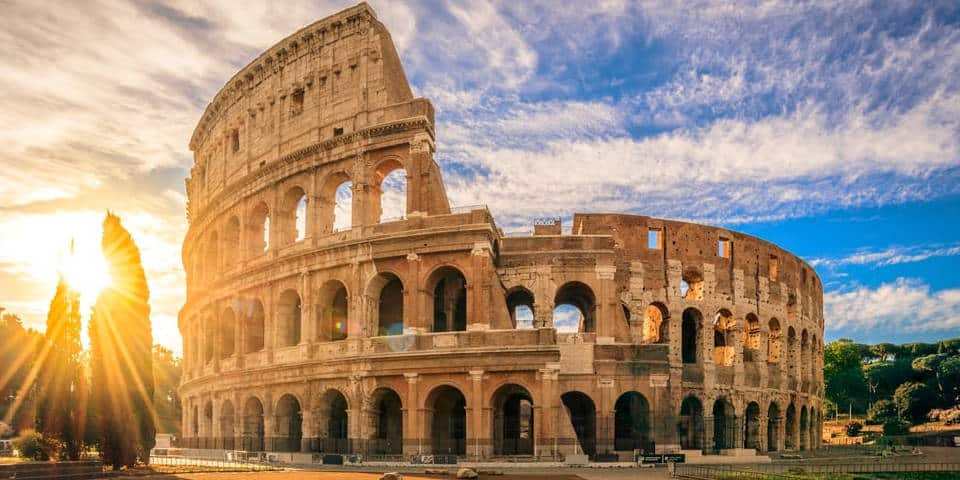

24827 views

| Tickets |
Buy tickets online: |
|---|---|
| Opening Hours |
Sunday:
-
Monday:
-
Tuesday:
-
Wednesday:
-
Thursday:
-
Friday:
-
Saturday:
-
|
| Recommended tour | |
| Closest bus stops |
|
| Closest subway stations |
|
| Address | Piazza del Colosseo, 1, Roma |
| Website | www.colosseum.how |
The Colosseum or Coliseum (Latin: Colossus – “huge,” Italian: Colosseo), also known as the Flavian Amphitheatre (Latin: Amphitheatrum Flavium), is perhaps the grandest construction in the history and culture of ancient Rome.
It is located to the South of the central part of the Eternal City, just east of the Roman Forum. Built during the extensive reconstruction of Rome, it had been the most prestigious place for entertainment in the capital and empire for four centuries. Over time, this colossal arena became the hallmark of Rome.
Contents
ToggleThe total ticket to the Coliseum will cost 18 euros. This price also includes visiting Palatine Hill and the Roman Forum. The access is active for 48 hours.
Discounted tickets will cost 7.5 euros, valid for E.U. citizens aged 18 to 24.
E.U. citizens can visit the Colosseum for free (reservation required) In addition, residents of the European Union under the age of 18 and after 65 can pass through a special entrance to the amphitheater free of charge.
You can try to buy tickets at the last minute at the box office opposite, see instructions. Keep in mind that only a few hundred tickets are available daily for visitors who have not purchased tickets in advance.
Reservation in advance costs 2 euros, but it helps avoid long queues at the ticket office. Also, do not trust guides offering their services next to the walls of the Colosseum.
The Colosseum was created around A.D. 70-72 by Emperor Vespasian of the Flavian dynasty as a gift to the Roman people. After, in A.D. 80, Vespasian’s son Titus opened this massive construction for 100 days of games with gladiatorial combats and wild animal fights.
At that time, the Colosseum was known as the Flavian Amphitheater. Romans actively used it for four centuries, but in the 18th century, the arena became a source of building materials. Consequently, two-thirds of the original construction has been destroyed over time. Still, the amphitheater remains one of the most famous touristic destinations globally and an iconic symbol of Rome.
In 64 A.D., the Great Fire of Rome wrecked the Eternal City. It happened during the rule of Nero, who appropriated the land and built a luxury palace with a lake and gardens, which we all know as Domus Aurea (“Golden House”). Also, 37 meters high statue of Nero was created on the site. However, the misrule of the emperor caused many civil wars. After his death and during the rule of Vespasian (A.D. 69-79), the new emperor, with his sons, Titus (79-81) and Domitian (81-96), tried to restore Senate and develop the welfare of citizens.
Finally, around 70-72, Vespasian restored Nero’s Domus Aurea and built a new arena for people to enjoy gladiatorial combats and fights with animals.
The Colosseum demanded massive input of materials and human resources for its construction. However, after the war with the Jews, Vespasian acquired more than 1000 enslaved people and the necessary funds for the amphitheater building. The beginning of work was in 71-72 A.D. He decided that the area between the three hills of Rome: the Caelian Hill, the Esquiline Hill, and the Palatine Hill, would be an ideal location.
When emperor Vespasian died, the helm of the state was passed to his son Titus (Latin: Titus Flavius Caesar Vespasianus Augustus)
The successor finished the building of the Colosseum and entitled its generic name – the Flavian Amphitheatre. Moreover, the building accommodated 50 to 80 thousand people, having, on average, 65 thousand visitors.
The Colosseum quickly became a place of attraction. Therefore, Titus, his brother Domitian (Latin: Titus Flavius Domitianus), and the following emperors of Rome always took care of it and improved the construction regularly. Finally, in the 3rd century A.D., the amphitheater was almost ruined because of a great fire, so Alexander Severus (Latin: Marcus Aurelius Severus Alexandrus) restored the structure.
In the 5th century AD, Rome renounced the pantheon of pagan gods to turn to Christianity. The emperor Honorius August (Latin: Flavius Honorius Augustus) immediately banned the gladiatorial combats because of contradiction to the precepts of the new religion. However, the Colosseum retained its status as the venue for entertainment but offered only fights of wild animals. In the 5th century, Italy fell under the domination of the West Goths, leading to the gradual destruction of the Flavian Amphitheatre.
At the end of the 6th century, a small shrine was built inside the Colosseum. The arena became a cemetery, while the niches and arches of the amphitheater were used for trade shops and workshops. In 1200, the aristocratic family, Frangipani, received the building with complete ownership and began to work on its fortification.
In the middle of the 14th century, an earthquake hit Rome and led to the destruction of the outer south wall of the Colosseum
From the 16th century, the church significantly influenced the Colosseum. Pope Sixtus V had planned to build a wool processing plant on the territory of the ancient site. In the 17th century, the amphitheater had a new entertainment – bullfighting.
In the middle of the 18th century, Pope Benedict XIV declared the Colosseum a holy place for the Catholic Church, the early Christian shrine.
Subsequently, the pontificate made numerous attempts to restore a historical place. Throughout the 19th century, there were widespread works regarding excavating the amphitheater arena and strengthening the damaged facade. The construction acquired its modern form during the reign of Benito Mussolini, known as Il Duce (“the leader”).
Nowadays, the Colosseum is one of the most famous sights of Rome. Thousands of tourists visit the Roman theater and the surrounding area daily, while the average annual flow of people reaches several million.
The external view of the Colosseum was borrowed from the theater. It is an ellipse-shaped construction with dimensions of 189 meters (620 ft) long, 156 meters (512 ft) wide, and a base area of 24 thousand square meters (6 acres).
Earlier, the outer wall height reached 48-50 meters (157-164 ft), while the perimeter was 545 meters (1788 ft). The arena has an oval shape with a width of 55 meters (180 ft) and 87 meters (285 ft). From the audience, it was enclosed with a five-meter (16 ft) wall.
The outer wall construction took about 100 thousand cubic meters (3,531,467 cubic ft) of travertine. Stones laid without cement were stitched with metal piles with a total weight of 300 tons. Unfortunately, the past centuries and a strong earthquake deprived the Colosseum of its former luster.
As a result, only the northern segment of the original construction has survived. The rest was used for building materials by the medieval inhabitants of Rome. Only in the 19th century did the city authorities decide to restore the historical place.
The undamaged part of the Colosseum consists of 3 tiers of arches set on each other.
The architects of antiquity faced a difficult task: they had to provide easy access to the massive stands of the amphitheater. For this purpose, they built 80 entrances on the underground floor of the construction. Moreover, 76 were intended for the “mere mortals,” while the remaining four were for August’s people. The main northern exit was reserved for the emperor and his entourage. Four “elite” entrances were decorated with artificial marble and favorably compared with ordinary portals.
To visit the amphitheater, the antique audience bought tickets on which the row and seat numbers were engraved. Visitors could get to the seat via vomitoria – passages below the stands. Also, vomitoria ensured the emergency evacuation of spectators from the Colosseum.
According to historical records of the 4th century AD, the amphitheater accommodated up to 87,000 spectators.
The basis of the arena was a thick wooden platform (“harena” in Latin) 83 x 43 meters (272 x 141 ft), covered generously by sand, which is hidden deep underground, called the “hypogeum.” By modern days, the original Roman arena almost didn’t survive. It consists of two-level tunnels and cages located under the arena. Moreover, this is where gladiators and wild animals were before the fight.
80 vertical lift platforms ensured the delivery of animals, including elephants, to the arena of the Colosseum
Such complicated mechanisms required constant repair and upgrades. A chain of underground tunnels connected the hypogeum to different points of the amphitheater and even beyond it. Also, the underground had a particular tunnel for the emperor’s needs and the Vestal Virgins.
Many different types of mechanisms have been located underground. For example, forerunners of elevators and structures opened cages of dangerous predators. Also, scientists have discovered the remains of the ancient hydraulic system, which allowed one to raise or lower the whole arena quickly.
The Roman Colosseum, an emblem of ancient grandeur, holds numerous fascinating secrets within its time-worn walls. As you prepare for your visit, discover these captivating facts about this iconic structure. They’ll enrich your experience and make for compelling conversation, leaving your friends marveling at your depth of knowledge.
The internal part of the Coliseum was severely damaged over time. Nevertheless, celebrities prefer only this area for their performances. These celebrities include Ray Charles, May 2002; Sir Paul McCartney, May 2003; Sir Elton John, September 2005, Billy Joel, July 2006.
The image of the Colosseum has been used in art many times: literature, cinematography, computer games, and music. The most outstanding examples of this:
Read also about How many Colosseums are there in Rome
Please read the complete list of hotels and our tips in an article about the best hotels near Roman Colosseum. Below is my 4 favorite hotels:
The Colosseum is one of the most important sites of the Eternal City. But, undoubtedly, the theater is worth visiting with its rich history and colossal size.
Author: Artur Jakucewicz
This website uses cookies. For more info read the cookies policy
Rome.us © 2025. Created with love by Roman experts and guides.